On August 18, 1920, the 19th
Amendment was officially ratified, bringing fruition to the women’s
suffrage movement and acting as a platform for modern day feminism. Since that
time, commonly known as feminism’s first wave, women’s rights movements have
progressed. During the early 1900s, suffrage was a primary concern of
feminists. Today, though, the issue is quite literally closer to home – family
life.
Neil Gilbert’s book, A
Mother’s Work: How Feminism, the Market and Policy Shape Family Life,
discusses the modern family and the choices faced by women today in terms of
motherhood versus an occupation. He begins by prompting the question: is
motherhood in decline? Articles appeared in newspapers all across the nation,
talking about an “opt-out revolution”, or the story of women choosing to stay home
and raise families instead of pursuing a career. Gilbert claims, however, an
assumption that women are choosing family over work is misplaced.

He continues on by talking
about the effects of capitalism on motherhood, addressing both a literal and
what is known as a “psychic” income, the latter being any non-material changes
that result from motherhood. In addition to this cost-benefit analysis, he asks
the reader to consider feminist expectations. What is the true meaning of
independence? Privilege, choice, and material possessions are all subjects that
are broached, which prompt a deeper consideration of how our society affects
our families.
To tie this back to voting,
the issue of “family friendly” policies is one worth noting. Gilbert concludes
his book that different policies may be conducive to certain lifestyles, but
not others. Controversies such as day care are discussed. Ultimately, Gilbert
encourages a new perspective on the pro-family debate—he advocates
consideration for alternatives for balancing work and family life. He cites
family/work policies of several other countries, saying that ultimately, women
need to educate themselves and seek the changes that they desire.
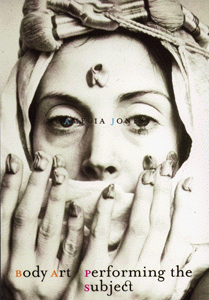
"The significance of Amelia Jones's Body Art/Performing the Subject cannot be overstated. Body Art is a book that is long overdue, and one that I suspect will drastically change the field of feminist art history, particularly as it concerns the performative art production of seventies artists." —Performing Arts Journal
"If art history traditionally has been a male-dominated enterprise, O'Dell and Jones renegotiate its gender. The stories these two writers tell, and the images they reproduce, suggest that their revisionary critical practices are not justified but revelatory." —Henry Sayre in Art Journal
"Insightfully self-reflexive and critical re-reading of modernism and postmodernism." —Saul Ostrow, Bomb
"In her latest book, Body Art/Performing the Subject, Amelia Jones locates her critical project with particular reference to the work of Maurice Merleau-Ponty, Simone de Beauvoir and Judith Butler, and thus joins the increasing number of feminist philosophers, film theorists and art historians exploring notions of performativity, embodied subjectivity, situated knowledges and the phenemenological intersubjectivity of the interpretive act. Jones's book represents a particularly powerful enunciation of the reconception of the subjectivity of the artist and the historian calling into question both the production and interpretation of art as moments of active negotiation of 'body/self' boundaries and limits." —Art History
This book is a scholarly exploration of the use of the body in performance art. Although the author’s style was incredibly dry, the work profiled was fascinating. The most compelling and representative essay for me was, ‘The Rhetoric of Pose: Hannah Wilke.' In this essay, Jones profiles an artist who explores physicality, identity, and decay. Wilke kept a photo diary of her battle with cancer, and in a series of photos, she details all the aspects of chemotherapy, including the loss of her hair.
In a photo entitled Brush Strokes, the viewer sees clumps of hair arranged as objets d’art. I found this last image particularly evocative and moving. So much of popular ideas of female beauty and femaleness itself, is associated with hair. Wilke deftly suggests loss, mortality and devastation with the scattering of a few items. It triggered for me ways in which I might want to tight shot of my own body parts in a photo collage about aging. It also resonated with others ideas I've encountered of artists claiming sexuality beyond airbrushed ideas of femaleness and "perfection."On a critical note, despite the book's tremendous strengths, Jones’ essays are limited in their global appeal due to a very dense, almost inaccessible style of writing. I realize that this is an ongoing criticism of mine, but it’s one that, sadly, I’m forced to make time and time again. Form and style continue to be a major way in which those who nominally control the art community exclude the general public. Class and cultural biases continue segregate artists of color and working class artists by exactly the language used in the book and the audience the author assumes is reading it. This is a self-defeating practice on the part of those who claim to be progressive artists, more understandable coming from the old guard which art critics like Jones claim to be reacting against.
Lastly, there is very little to be found in the way of emotional content in the book. I kept wanting to ask: “But how did viewing this piece make you feel?”
Still, Jones provides the reader a provocative opportunity to explore the work of artists pushing the envelope, who use their bodies to explore identity, culture, gender and race. I was challenged to think how I can continue use my body sparely and truthfully to look at the same themes.
Alicia Gaspar de Alba. NY: St. Martin's Press, 2007.
ISBN: 0-312-36641-8
Michael Sedano

Alicia Gaspar de Alba has done it again, created an incredibly arresting novel,
Calligraphy of the Witch. It’s a deeply emotional story with some of the same flavor as Gaspar de Alba’s important 1999 novel,
Sor Juana’s Second Dream. In
Calligraphy of the Witch, a character from Sor Juana’s convent—the nun’s scribe, in fact—frees a slave from the sadistic Mother Superior and they flee hopefully to freedom they seek in a black colony near Vera Cruz. But Aléndula, the slave, and Concepción Benavídez, the amanuensis, are captured by a Dutch slaver and carried into rape and captivity, up to Boston.
The pirate captain’s surname, de Graaf, is too much for the British tongue, so he’s been christened Seagraves by the Boston merchants. When he sells Concepción as a slave, her given name is irrelevant and the Greenwoods name her Thankful Seagraves, in honor of her freedom to be their slave.
Gaspar de Alba partitions Concepción’s story into manageable parts. An introduction in a daughter’s voice. The brutal voyage from New Spain, her earliest years in Boston, a middle passage when Thankful Seagraves is married to the old man Tobias Webb--Goody Greenwood’s father-- Concepción’s trial and imprisonment as a witch, and the end story. Several passages are typeset in script in the manner of a scribe. Fortunately, the script font is entirely legible, thus adding to the reading experience.
The voyage to New England for the twenty-something Concepción is one rape after another followed by beating and all manner of brutality. Unknown to the dark-skinned de Graaf, he’s impregnated the girl with his blonde genes. That’s what Concepción’s daughter looks like, far more resembling Rebecca Greenwood’s blonde blue-eyedness than the mestiza birth mother’s brown skin and bi-colored eyes.
The merchant Greenwoods have been unable to sire another offspring, so Rebecca starts a devious program to steal the child and raise the girl as her own daughter. This entails turning the child against the mother in truly horrific ways. The culture of the Visible Saints breeds hatred into the child, and when the mother Thankful Seagraves is arrested for witchery, her Popery, the devilish Spanish tongue the mother speaks provide persuasive evidence of guilt. Even more persuasive is the brainswashed daughter has provided the most damning evidence, such as the devil’s own creed embroidered on a cloth the mother lovingly insisted the child memorize:
Hombres necios que acusáisa la mujer sin razón,sin ver que sois la ocasiónde lo mismo que culpáis:si con ansia sin igual solicitáis su desdén,¿por qué queréis que obren biensi las incitáis al mal?Forced to translate, Concepcíon recognizes how Sor Juana’s satire could turn itself into evidence before the clouded evil of Cotton Mather and his ilk:
Whose is the greater faultIn an errant passion?She who falls for pleading,Oh he who, fallen, pleads?Who is more to blame,Although both be guilty of transgression,She who sins for a commission,Or he who for sin will pay?Hence with much logic do I unravelThat men’s arrogance wins the battleFor in ways direct or subtleMen are the sum of world and flesh and devil.With Concepción’s differences with her world viewed therein as not mere deficits but signs of evil, the reader is not surprised at the tragic consequences that befall the Mexican slave. Yet, the author keeps the reader hanging on every incident and development. Despite foreshadowing the story’s most tragic elements—the novel’s introduction in the estranged daughter’s voice, the seer’s vision that daughter would be stolen by the barren merchant’s wife and turned against mother, Concepción’s education at Sor Juana’s hand plopped in the middle of superstitious Puritans—Gaspar de Alba keeps a reader in thrall through every incident and stomach-turning violation.
Against these fearful pressures, Alicia Gaspar de Alba builds an almost unbearable tension. Will the innocent woman be hanged as were others? Will the daughter discover the truth, and if discovered, accept it? What could possibly save Concepción from the inevitable? So intense does the author build the tension that the reader keeps turning pages repeating the incantation, “it’s only fiction, it’s only a story”.
An excellent story, and, as one would expect, more than a mere historical exercise. There’s a strong contemporaneity in Concepcíon Benavídes’ Thankful Seagraves story that reflects our times or echoes themes of earlier literatura chicana. An uneven struggle for identity caught in the conflict between the weaker Spanish-speaking culture and the dominant English-speaking world creates strength in the parent but a burning desire of the daughter not to be seen as her mother’s child. As the witch hysteria begins to cool, the validity of confessions won through torture takes on a clarity for some that others refuse to accept. An underlying greed and covetousness masked by the guise of righteousness infects the rise and ebb of injustice.
Concepcíon is one of those flies to wanton gods who bounces helplessly from powerful enemy to powerful enemy until the abuse grows too great. Much of the tension in Calligraphy of the Witch grows from the seemingly total helplessness of women and the evil of men. What’s a woman to do? When Greenwood’s lust turns to rape, in a blind rage Thankful Seagraves wraps a rope around her former owner’s neck and throttles him good. The reader’s heart leaps with joy, so completely evil a character Gaspar de Alba has crafted, then sinks in dread. Had she killed him, there could be no possibility of reprieve. But what of hope? When a woman is battered so much that her only recourse seems to be murder, what should she, what can she do?
Among Concepcíon’s practices is writing letters to Sor Juana, Aléndula, and Concepcíon’s mother, only to burn them later, in the woods. This deviltry becomes evidence against her in her witchery trial. But in one such letter, the scribe offers a lesson she hopes her daughter might one day profit from:
“Aléndula once told me that there are always four choices to every decision: the wise choice, the foolish choice, the safe choice, and the choice that someone else makes for you. “
In the end, Hanna Jeremiah Greenwood, née Juana Jerónima Benavídez, is faced with this logic. It is 1704. Her mother has been gone a decade, and Mama Becca has died, too. Hanna Jerónima, la bebita de Concepcíon is a mother of twins whom she’s named in English after herself and her unknown Mexican grandmother. Daughter comes to a point in her life when she can finally shed herself of all that heritage and go on with her English life. She will make one of those four choices, either leaving the reader frustrated, or completely frustrated, either a little joyful or fully relieved. In that welter of emotions will be a bit of sadness accepting that the story did have finally to end.
La Bloga welcomes your comments and observations and this or any column. Equally welcome are guest columnists. Please express your interest in being our guest by clicking here, or leaving a comment during the week.

By: Lisa Alvarado,
on 3/20/2008
Blog:
La Bloga
(
Login to Add to MyJacketFlap)
JacketFlap tags:
multicultural,
creativity,
poetry,
Pat Mora,
poem,
community building,
women of color,
women's studies,
prayer,
multicultural literature,
political art,
books to buy,
chicana,
Add a tag
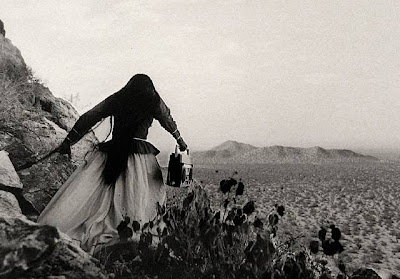 STORMING HEAVEN'S GATE -- photo by Graciela Iturbide
STORMING HEAVEN'S GATE -- photo by Graciela Iturbide
This is a multicultural anthology of spiritual writings by women. In rediscovering spirituality in a female context, this is ideal source material. By ‘source’ I mean personal soul food to feed my own yearnings, ground water for the wellspring of my daily life. Storming Heaven’s Gate skillfully bridges the everyday with the divine, featuring the writing of Pat Mora, Lucille Clifton, and Audre Lorde. I would like to comment specifically on the work of these women and its impact on my creative life.
Pat Mora’s contribution is a list poem, in which she invokes the Goddess through her many Aztec names. In a cry for wholeness and renewal she calls on Coatlicue, Tlaliyolo, and the Virgin de Tepayac/Guadalupe. Coatlicue is the serpent mother, representing all and nothingness from whence all emerges. Tlaliyolo is the creator/destroyer of worlds, and the Virgin of Tepeyac/Guadalupe is the eternal maiden, ever able to renew herself across the ages. The world springs forth, eats itself, springs forth again, dissolves itself in velvet blackness, and rises again, as one, as many, divine and common. These facets of the divine reflect exactly the kind of sensual, radiant cycle of spirituality that are the hallmark of Storming Heaven’s Gate.
Creatively and personally, I needed to engage the Goddess in a Latin context. In doing so, I found freedom from restrictive ideas of female identity that have been Catholicism's and colonialism's legacy. It is precisely the idea of sin, of the inherent pollution of women’s bodies, that had to be broken through for me to fully claim my creative energy and direct it.
As I continue to try to make new work, I have to reach out for connection in an ever-deepening way. My personal spirituality is being plumbed for imagery, for language, for a way to connect with something larger than myself.
Ironically, and in a way I can only begin to comprehend, this spiritual connection is plumbing me as well. What I mean here is that I can't forget that writing is my tether to something divine. Personal success, critical or audience acceptance needs to remain a secondary consideration, as much as care about those things. ‘What is being worked though me?’ is the question that I have to ask myself, the question that demands an answer at the end of the day.
In 'brothers, part 6,' Lucille Clifton cries out to a silent God who turns a deaf ear to suffering. She asks:
tell me why
in the confusion of a mountain
of babies stacked like cordwood...
tell me why You neither raised your hand
nor turned away...why You said nothing. (p.28)
I can feel my own tears lodge in my throat as I write this. What a terrible beauty exists in her description of both a personal and global apocalypse. Her wound, her grief, the abandoned bodies of nameless children, unsaved, unprotected.
Clifton asks the eternal question of a God she desperately wants connection with but does not understand. I remember my own rage at what I saw at the time as God's silence in the face of my own childhood abuse. I see now that what happened was part of my story unfolding, the catalyst for who I've become. It was a singular gift, a defining moment, in which I had to choose to live and to transform. In my case, that moment is where I encountered a God/Goddess.
Lastly, Audre Lorde illustrates the kind of language and imagery I can only hope to achieve someday. She was poet, theorist, theologian, lover, survivor, and griot - someone who once tore down the Master's house and built a temple to the New/Old Mother. One poem in particular kept speaking to me, even in dreams after I read it for the first time. In it, Lorde writes:
Attend me, hold me in you muscular arms, protect me
from throwing any part of myself away. (p.67)
How perfect this quote is, to its vision of encountering the very dark and moving into the light. How moving it is to hear a call to restoration and rebirth in a woman’s voice, shaped by She-Who-Is.
Lisa Alvarado

By: Lisa Alvarado,
on 3/5/2008
Blog:
La Bloga
(
Login to Add to MyJacketFlap)
JacketFlap tags:
interview,
women of color,
women's studies,
playwriting,
women and performance,
Teatro Luna,
Latina,
Johanny Vázquez,
playwriting,
women and performance,
Johanny Vázquez,
Teatro Luna,
Latina,
Add a tag
Teatro Luna Fabulousness!
Teatro Luna has a BRAND NEW SHOW opening on March 6th, but you can catch it now! This Saturday and Sunday see a sneak preview of Teatro Luna's most intimate show yet... SOLO TU, a collection of four interwoven solos all about different women's experiences with PREGNANCY.One woman thinks she's finally built the perfect family - Mom, Dad, Cute Kid- until an invasion of mice makes her wonder what's really going on. Another woman finds herself caught up in the worst kind of Baby-Daddy-Single-Mama Drama. Meanwhile, a woman in her third year of trying to get pregnant decides her pregnant friends make her want to vomit, and her close friend wrestles with pro-life activists, hospital robes, and how she feels about having an abortion in her 30's.Saturday @ 7:30 pm and Sunday @ 6pm
SHOW RUN: March 6-April 6 2008 Thursdays, Fridays, Saturdays @ 7:30 pm Sundays @ 6pm Chicago Dramatists 1105 W. Chicago Ave, at Milwaukee Tickets $15, Student and Senior Discount on Thursdays and Sundays only, $10 $12 Group Sale price, parties of 8 or more For tickets, visit www.teatroluna.orgMind, you the company is filled with talented, writers and performers, and it was rough to pair down, but gente, enjoy this interview with three of Teatro Luna's members, Diana Pando, who does administration for the group as well as writing, Tanya Saracho and Diana Herrera, both writers/actors.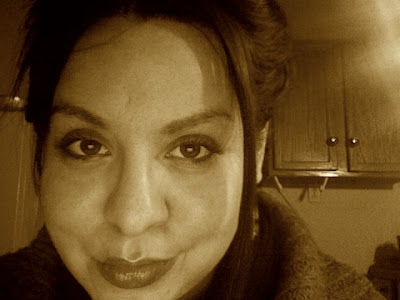 DIANA PANDO
DIANA PANDO
Talk about the differences in each. Is there a genre you feel is your "favorite?"As an emerging writer, I think my strengths are poetry and fiction writing. I’m dabbling in playwriting because I’m absolutely fascinated by creating dialogue and having actors bring the characters to life. Even though I’ve been doing theatre administration for Teatro Luna they teach me so much about the process.Talk a little about Proyecto Latina. What do you hope it provides for community writers, and book lovers?Proyecto Latina is a wonderful community based initiative between Tianguis Bookstore, Teatro Luna and myself. This open mic takes place every 3rd Monday of the month at Radio Arte and it’s a place for Latina’s to come out and show off their talent whether it’s poetry, fiction writing, belly dancers and Hula Hoopers it’s an open mic that brings together emerging and established Latinas in the arts to share, explore and encourage their creative pursuits. We are impacting that next generation by giving them an outlet to show off their creativity. Irasema Gonzales, owner of Tianguis Bookstore, has done an amazing job of lining up some the best features. There’s even a chismé box where you can drop your anonymous chismé and we read them during the open mic. Please drop in and check it out. Log on to http://www.tianguis.bizWhat are you sources of inspiration? A source of inspiration for me is walking through the city. I’m a big fan of long walks despite a toe spur gone amuck. Anyway, too much information. Friends always look at me with suspicion when I tell them we are just three blocks away. Rightfully, so I guess. Three blocks is the equivalent of ten blocks for me. I’m a wanderer. I love to look at people, places and things. Me embobo luego, luego, especially when I’m in Mexico City. There is nothing like being in the Zócalo on a rainy day. Definitely inspires and leaves me drenched. I always forget my umbrella…What's the role of female friendship in your daily life and as a writer?Funny you should ask this question. It’s my lifeline! I can’t go back to anything else. In 2002, Irasema Gonzales invited me to see a reading of Sandra Cisneros up at Loyola. I was feeling a little lazy and it was cold out. Thankfully, she dragged me out there anyway. It was an amazing reading and what came out of it was such a blessing. After the reading Sandra was signing her book and answering questions. There was this annoying girl with a red shirt talking and talking to Sandra. “Hurry Up” I wanted to yell “We want to talk to Sandra too!” The line finally began to move and when we got there Irasema asked about writing groups and Sandra told us to connect with the woman in red. The woman in red is now a dear friend and fabulous writer. Our writing group consists of Lizann Acosta, Professor of World Literature & Teatro Luna Artistic Associate, Irasema Salinas, Tianguis Bookstore Owner, Family Dr. Yolanda Cardenas, Magda Banda Ph.d Candidate in Comparative Education and me. Sandra probably has no idea but she’s our writing group madrina.Where would you like to be creatively and professionally in ten years? In ten years, I will be producing consistent work in different generes of writing, collaborating with other Latinas on projects, encouraging Latino professionals to support the arts through philanthropy, create the Mariposa Atomica Arts Fund and do advocacy work for the arts. Latinos enrich the arts in the city of Chicago and it’s important that we support and cultivate those efforts.Tell us something not in the offical bio.I have an 800 pound Dalmation and he’s more than a decade old, I’m a mascara junkie and my favorite mantra is vision + action = Reality.
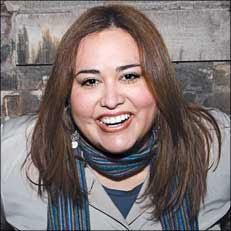 TANYA SARACHO
TANYA SARACHO
(Courtesy Time Out Chicago)
Talk about the differences in each. Is there a genre you feel is your "favorite?"I'm mostly a writer for the stage. I don't have a talent for poetry. I respect poets immensely. To be able to structure and mold words aurally and rhythmically is a talent I truly admire.Talk a little about Proyecto Latina. What do you hope it provides for community writers and book lovers?I can't believe we've been doing Proyecto Latina for two years now. I remember the first time we did it, and how we filled Meztli Cafe and how every one was excited about every performer. You could feel the electricity in the place. Not much has changed, the location perhaps, but people are still excited to hear and support new work by Latina writers-of all genres, not just poetry. It provides a much needed outlet and cocoon to nurture our work.What are you sources of inspiration? What's the role of female friendship in your daily life and as a writer?All my plays are about females. I don't think that's limiting in the least; They all deal with a female central character and I can't deny it, each and every one has at least a bit of coloring that I draw from the women in my life. My mother, my sisters, my Teatro Luna sisters (who are more than friends)... I take the ribbons of vernacular from their mouths and plaster them on the stage. Their words are much more brilliant than mine will ever be. They are wise and funny and flawed. It's my friend's Yadira's zinger lines and her obsession with the perfect meal. It's my friend Miranda's struggle for her dreams and the sting failure causes. It's Tatiana's depression and her unwillingness to come to surface, but her attempt at it every day. It's my friends navigating their contradictions. Those things are much more interesting than anything I'd come up with on my own. Now I might piss people off. Make them angry because I just take one tiny little shade of blue here, or a smudge of brown and they think that's definitive of my opinion of them. But that's never the case. I am often in trouble for it though.Where would you like to be creatively and professionally in ten years?I'd love to be feeding myself fully with the work. Sharing it with as many people as possible. In whatever form. Whatever that means. Whether bigger stages. More productions. Far reaching publications. I'm not sure what that means, but I'd like to have figured it out and be in a place to open doors for other people. Be on the founding stage of programming that makes sure our voice is being heard. In ten years I would have liked to have gotten out of my myopic state and attempt a period piece about hoodoo in the American South during the late 1800's. Nothing to do with Latinidad. That's just a little project that has been rattling in my brain. But it's a long time for that one. In a decade, I'd like to have a cannon of work I can be proud of, but having the best yet to come. Also, in ten years Teatro Luna will be an institution; financially healthy, administratively strong, artistically excellent. Still doing the work.Tell us something not in the official bio.I am addicted to divination and getting my cards read. Every week. Every. Week. My name is Tanya Selene Saracho Armenta, and I am a divination addict.
 DIANA HERRERA
DIANA HERRERA
Talk about the differences in each. Is there a genre you feel is your "favorite?"I don't work too much in poetry, except what I write in my journals that will never been shown to ANYONE 'cause it's really bad poetry! But here we go with the other two. My favorite has to be playwriting because I think I have a God complex. Seriously, it's intoxicating to create this whole world and populate them with these people that use YOUR WORDS to express themselves…then if you're lucky you get a chance to see it LIVE!! How cool is that? Also, though…there is that moment of CONNECTION. When you make a bulls-eye with the hearts of your audience members. There is nothing as gratifying as when someone comes up to me after a show and tells me, you were writing about me. I wrote a piece in "The Maria Chronicles" about visiting my brother in prison, and after shows I had several people tell me about their experiences with family members in prison. One lady told me that after my piece she reconciled with her brother and visited him for the first time in years. That really touched me. It might sound trite, but it's true…writing plays for me is like reaching out and saying "I'm not alone, you are not alone…for this moment we will be taking this journey together". I write because sometimes these feelings I have are so intense it becomes necessary to overflow them onto paper. I chose to share my journey, though, instead of locking it up in a diary (well, except my poems. Those don't need to be shared!).So where does performance fit in? To me, performance is another level of connection with the audience. It's very cathartic, and it's wonderful because you get instant gratification…laughter during a one-liner delivered just right, silence during a dramatic moment…applause. Oh, the applause! Performing is such a high, because you are on this tightrope wire where any sudden change (even something like the theater being too hot or the seats too uncomfortable) will distract your audience…you have to EARN their attention…but once you've earned it what a RUSH.Talk a little about Proyecto Latina. What do you hope it provides for community writers and book lovers?I've enjoyed participating in Proyecto Latina in the past…unfortunately I've been absent from the monthly events for a while. However, I think it's such a wonderful opportunity for new artists…and I LOVE that there is a set limit of people that can perform, that it's a 5 minute time limit and that there is a featured performer. That is key…to be able to enjoy these "tastes" of performance without being overwhelmed by a 4 hour open mike. I know being able to hear various artists has inspired my own writing. I'm hoping I can start attending again…I've missed it!What are you sources of inspiration? What's the role of female friendship in your daily life and as a writer?My family is a HUGE source of inspiration for me—we have this carefully honed sense of humor that I use in my writing. They are very supportive of me—I talk a lot about them in my pieces and I haven't been disowned. Yet. I love comedy, so of course I'm all over female writers like Tina Fey—even watching the old episodes of The Carol Burnett Show gives me inspiration as a writer. Currently I'm working on a two-woman show, and we are using "The Search for Signs of Intelligent Life in the Universe" as inspiration…Jane Wagner and Lily Tomlin collaborated on this piece, and it's amazing.Where would you like to be creatively and professionally in ten years?Creatively, I'd like to still be writing and getting my work produced…if I can perform occasionally that would be a bonus. It's hard because I do have a family now, and I'm the primary breadwinner…so not only do I have to balance work with family, I have to find time to write and stay involved in projects as well. The good thing is that my husband is VERY supportive—in fact, he's the one that keeps pushing me to take on these projects and he's great about covering the night shifts at home, taking care of our daughter and the house. So it's just a matter of figuring out what the next step is…the point is, I can't figure out next year, much less TEN years from now!!Tell us something not in the official bio.I am a HUGE fan of science fiction—my favorite authors include Ray Bradbury, Richard Matheson, HP Lovecraft, Charles Beaumont…and I LOVE TV shows like "The Twilight Zone", "Heroes", "Lost"�anything with a sci-fi edge to it! And yes, I was one of those geeks that stood in line for Star Wars tickets. Han Solo was my first crush.
xxxxxxxxxxxxxxxxxxxxxxxxxxxxxxxxxxxxxxxxxxxxxxx
Women and Creativity Conference/Lisa Alvarado Shameless Self-Promotion Department Gente: I've been blessed enough to have been asked to perform
The Housekeeper's Diary at the conference --
Friday, March 7, at 8 PM at the
National Hispanic Cultural Center's Roy E. Disney Center for the Performing Arts, as well as a reading for high school students at the Center's Wells Fargo Auditorium, Monday, March 10th at 10 AM.
Conference Info:
Women and Creativity 2008 is organized and presented by the
National Hispanic Cultural Center in partnership with more than 25 local arts organizations, artists, writers and independently owned-business. This year, we have an inspiring offering of more than 50 exhibitions, performances, workshops, classes, and engaging discussions in Albuquerque and Santa Fe.
Women and Creativity partners invite you to dedicate an afternoon, evening or entire weekend in March to attend events and workshops that awaken and nourish your own creativity and support the creativity of our communities. Although we shine a special light on women’s creativity during this festival, we invite and encourage the participation of men at all events.
The National Hispanic Cultural Center, along with our partners in
Women and Creativity 2008, believe that creativity, art and self-expression are central to sustaining healthy individuals, organizations, business and communities – so, join in and celebrate the creative women in your community and the creativity inside yourself.
There will also be a fabulous
PEÑA FEMENINA Sunday, March 9th at
NHCC's LA FONDA DEL BOSQUE;Other Artists:
Alma Jarocha,
Leticia Cuevas, Anabel Marín, Otilio Ruiz, Victor Padilla
Jessica López
Bailaora Xicana, Flamenco
marisol encinias, vicente griego, ricardo anglada
Lenore Armijo
Angélica
Cuevas
National Hispanic Cultural Center 1701 4th St, SW Albuquerque, New Mexico
More Conference News from Demetria Martinez
On Saturday, March 8 at 3 p.m. the first-ever Spanish-language anthology of work by women who reside in New Mexico will be unveiled at the National Hispanic Cultural Center in Albuquerque. Titled Metamorfosis, the book was co-founded by Demetria Martinez, Rosalee Montoya-Reed and Maria Nieves de Abajo Bajo. Please join us to celebrate International Women's Day, poetry, the Spanish language and creativity. A reception will follow. Please RSVP at 724-4777.
And Lastly, news from La Divina, Johanny Vasquez
Hola to Everyone: I will be participating at the Nuestras Voces: Women's Poetry Night at the University of Illinois Urbana-Champaign this Thursday, March 6, 2008. The event will take place at from Caffe Paradiso7:00 to 9:00 pm. This will be my first time at U of I, so I'm extremely excited. If you live in the area or know people that live in Urbana/Champaign, please come by or let them know. For more information got to my blog at:http://johannyvazquezpaz.blogspot.com/ or to the University Site at:
http://www.mechauiuc.org/ThursdayChicanasLatinasInTtheArts.html Hasta la vista, Johanny
Lisa Alvarado
Please take some time to read about the land struggle that is currently underway, and not being covered by mainstream media. Margo Tamez, author of Naked Wanting and Raven Eye, wants readers to know about the struggle between the Department of Homeland Security and native peoples on the issue of border rights.
Border struggle article, here.
For background on Margo, her poetry, and her commitments, read my conversation with her, here.
Lisa Alvarado
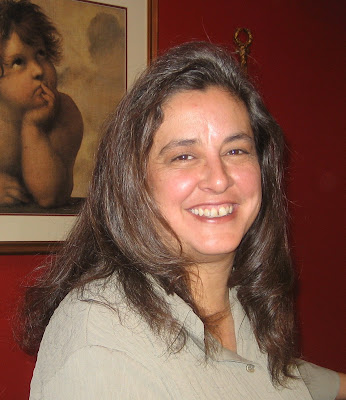

Sheryl Luna was born and raised in El Paso, Texas. Her collection of poetry Pity the Drowned Horses won the first Andres Montoya Poetry Prize sponsored by the Institute of Latino Studies and the creative writing department of the University of Notre Dame. The judge was Robert Vasquez. The collection was profiled in "18 Debut Poets who Made their Mark in 2005" by Poets and Writers Magazine. A graduate of Texas Tech University, she earned a doctorate in contemporary literature from the University of North Texas and a M.F.A. from the University of Texas at El Paso. She also holds a M.A. in English from Texas Woman's University. Her work has appeared in Feminist Studies, Notre Dame Review, Georgia Review, American Literary Review, and many other nationally acclaimed journals. She's received scholarships from the Provincetown Fine Arts Work Center and the Napa Valley Writer's Conference. Pity the Drowned Horses was a finalist for the National Poetry Series and the 2006 Colorado Book awards. Her second manuscript of poems, titled 7, was recently runner-up for the Ernest Sandeen Poetry Prize sponsored by University of Notre Dame. She currently teaches at the University of Colorado in Boulder, Colorado.
Bones
Once, as a girl, she saw a woman shrink
inside herself, gray-headed and dwarf-sized,
as if her small spine collapsed. Age
and collapse were something unreal, like war
and loss. That image of an old woman sitting
in a café booth, folding in on herself, was forgotten
until her own bones thinned and hollowed,
music-less, un-fluted, empty.
She says she takes shark cartilage before she sleeps,
a tablet or two to secure flexibility and forgets
that pain is living and living is pain.
And time moves like a slow rusty train
through the desert of weeds, and the low-riders
bounce like teenagers young and forgiving
in her night’s dream. She was sleek in a red dress
with red pumps, the boys with slick hair, tight jeans.
She tells me about 100-pound canisters of lard
and beans, how she could dance despite her fifth
child, despite being beaten and left
in the desert for days, how she saw an angel
or saint glimmer blonde above her, how she rose
and walked into the red horizon despite
her husband’s sin.
I’m thinking how the women
in my family move with a sway, with a hip
ache, and how they each have a disk
slip. The sky seems sullen, gray, and few birds
whisk. It’s how the muse is lost
in an endless stream of commercials, how people
forget to speak to one another as our ending skulks
arthritically into our bones, and the dust
of a thousand years blows across the plain,
and the last few hares sprint across a bloodied
highway. Here in the desert southwest, loss
is living and it comes with chapped lips,
long bumpy bus rides and the smog of some man’s
factory trap. And there are women everywhere
who have half-lost their souls
in sewing needles and vacuum- cleaner parts.
In maquiladoras there grows a slow poem,
a poem that may only live a moment sharply
in an old woman’s soul, like a sudden broken hip.
And yet, each October, this old woman rises
like the blue sky, rises like the fat turkey vultures
that make death something beautiful, something
towards flight, something that circles in a group
and knows it is best not to approach death alone.
Each October she dances, the mariachis yelp
and holler her back to that strange, flexible youth,
back to smoky rancheras and cumbias, songs
rolling in the shadows along the bare Mexican hills.
She tells me, “It’s in the music, where I’ll always
live.” And somehow, I see her jaw relax,
her eyes squint to a slow blindness
as if she can see something I can’t.
And I remember that it is good to be born of dust,
born amid cardboard shanties of sweet gloom.
I remember that the bare cemetery stones
in El Paso and Juarez hold the music, and each spring
when the winds carry the dust of loss there is a howl,
a surge of something unbelievable, like death,
like the collapse of language, like the frail bones
of Mexican grandmothers singing.
Ambition
Danny Lopez was so dark that some thought he was black.
His eyes were wide and wild.
When he ran, his short frame’s stride heated the streets.
Sweat trickled down his bony face, and his throat
lumped with desire, the race, the win.
We used to sit on the hood of my parents’ car,
gaze at the stars. He would win state,
dash through the flagged shoot in Austin,
get a scholarship to Auburn, escape the tumbleweeds,
the dirt floors of his pink adobe home, his father’s rage.
We were runners.
Our thin bodies warmed with sweat, and the moon round
with dreams of release. We lived a mile from the border;
the Tigua Indian drums could be heard in the cool evenings.
Our rhythmic hopes pounded dusty roads, and cholos
with slicked hair, low-riders, were only a mirage.
We drove across the border, heavy voices, drunk
with dreams, tequila, and hollow fears. We ran
trans-mountain road, shadows cast cold shivers
down our backs in the hundred-degree sun.
Danny ran twenty miles, finished, arms raised
with manic exultation.
The grassy course felt different beneath his spikes,
and the gun’s smoke forgotten in the rampage of runners,
his gold cross pounding his chest to triumph, his legs
heedless to pain, his guts burning.
Neither of us return to the cement underpasses,
graffiti, and dry grass, though I know
the drums still beat when we look at the stars,
and our eyes flicker with ambition.
Brown children in tattered shorts still beg for pesos,
steal pomegranates and melons.
Young men with sweaty chests and muddy pants
ask my mother for work, food,
passage to that distant win
somewhere on the other side of Texas.
Today the green trees are wet with rain,
and I am too lazy to run. The desire to run my fingers
down an abdomen tight with ambition, is shaky, starved.
It’s been too long since I’ve crossed that border,
drunk tequila, screamed victorious
at the mountain. The stars seem small tonight,
they don’t burst over the sky like they did back then.
These poems, these books don’t ravish me
the way Danny could, the way the race could.
His accented English, broken on the wind, and his run,
his lean darkness, drove exhaustion to consummation.
The wind seems too humid in this preferred place,
and when I hear throaty Spanish spoken in the lushness,
I long for the grimy heat,
the Rio Grande’s shallow passage,
the blue desert, and the slick legs of runners
along the smoggy highway.
The Cordova Bridge
I’m not writing delicate silver birds or some Southwest
aubade. I am rough in a pebbled and stickered dead sea.
And here, crazy-sad among the flowerless places
I sweat my way through the dirge of horns and radio
blues. Smog- filled air. Sweaty dark-dirty children hang
on my car. Their paper cups hold out a coinless surrender.
El Pasoan’s call them scam-gangs. Bumper to bumper
as a rainbow smears the sky, window-washers beg for dimes.
The streets narrow in Juarez. Gaudy green hand-painted
school buses block signs. The poor wait. A bright scholar
described las ciudades hermanas as unmoving. Blue hills,
the river’s banks deceiving us to see one-sided, blind. Juarez,
me later driving in circles, cursing the mad stops, the move-over
hurriedness. El Paso’s streets are wide, people erect chain-
link fences, bars over windows. They love their small plots
of land, their jalopy cars. A poet once sang a maid’s daily
dread over Cordova. I think I see her sweating away.
I once drew a breath of lush serenity, words danced
as small breaths, gilded beads. But you see, I was cursed
in this dust, crystallized among charcoal frowns and smiles.
At times, anger is an unnamed cry. Must one sing lichen,
lagoons, a glint of sky, creamy white breasts? Here, men
and women living bare dance among crumbling things. A man
without a leg has hopped that bridge for thirty years eyeing
shiny red Firebirds. What was a bird of red-fire to him?
Do we all rise phoenix-like from our tumbleweeds? Rain-
wash twirls about brown knees, rolled jeans, bare feet.
Popsicle-sellers close tiny carts, cigarette boys cover
damp cartons. And I am dry as an American can be.
- ISBN-10: 0268033749
- ISBN-13: 978-0268033743
Lisa Alvarado

By: Lisa Alvarado,
on 1/23/2008
Blog:
La Bloga
(
Login to Add to MyJacketFlap)
JacketFlap tags:
spirituality,
poetry,
meditation,
non-fiction,
theater,
poem,
community building,
women's studies,
Buddhism,
readings,
Teatro Luna,
Acentos,
Rich Villar,
Add a tag
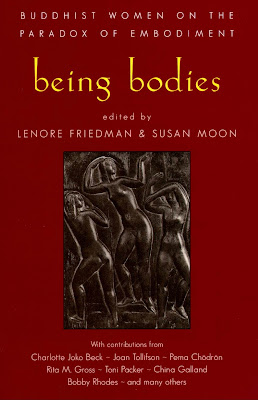 In Being Bodies, Lenore Friedman and Susan Moon offer the perspectives of a variety of women with varying Buddhist practices. The result is a contemplative and compelling work dealing with what it means to be female, what it means to fully and consciously inhabit the female body.
In Being Bodies, Lenore Friedman and Susan Moon offer the perspectives of a variety of women with varying Buddhist practices. The result is a contemplative and compelling work dealing with what it means to be female, what it means to fully and consciously inhabit the female body.
The last wave of the Western women’s movement critiqued the idea that a women was her body. In fact, a major focus of that movement was the position that biology was not destiny. This was primarily a response to the social construction of women’s identity, the objectification of a women as nothing more than physical self. However, there was little offered to support women in learning to fully live in that physicality, to know it as both vessel and endpoint. Being Bodies offers a view that a woman’s self-knowledge is rooted in the flesh. Women’s awareness is based in surrendering to the body’s impermanence, its joy, its suffering, and its death. One of the most thought-provoking essays is Linda Chrisman’s "Birth".
In it, she describes the process of labor, and giving birth to her son. What's striking about this experience was how Chrisman was both deeply enmeshed in that process and separate from it. The most telling lesson, for both Chrisman and the reader, occurred at the height of labor. Here she realizes that all her physical conditioning, all her contemplative practice would not save her from pain. This selection beautifully illustrates the message of Being Bodies. There may be another path for women, rooted in surrender to the fullness and limits of the body. Through that choice, a woman may find self-knowledge and ultimately, freedom. While the focus of Being Bodies is the female experience, it is a universal and object lesson about Buddhist ideas of impermanence, and becoming fully present in every moment by letting go. I was moved to tears reading this book. It reminds me that true beauty is the sum of both pleasing things as well the scars.
I feel such a strong, visceral connection to the stories of the women profiled in this anthology. (Interesting that "visceral" is the only word that comes to mind in reviewing a book dealing with the experience of being grounded in the body and the odyssey of transcendence.) This book is a pivotal one as I try to develop a deeper spiritual practice - moving East in order to come West, hoping to re-encounter and reinterpret my own ideas of embodiment, spirituality and existence.
ISBN-10: 1570623244 ISBN-13: 978-157062324
XXXXXXXXXXXXXXXXXXXXXXXXXXXXXXX
Acentos and AWP Conference News
On Tuesday, January 29th at 7pm, we break from our normal schedule to bring you
ACENTOS on a FIFTH TUESDAY, in conjunction with the Bay Area's own
Craig Perez and
Achiote Press.
The featured poets that night will be two amazing young writers:
Marina Garcia-Vasquez, a
contributor to the press' ACHIOTE SEEDS, Volume 2, and Javier O. Huerta, author of the acclaimed debut collection, SOME CLARIFICATIONS Y OTROS POEMAS. As always, the Uptown's best open mic will precede the festivities, and your host will be John Rodriguez.On Thursday, January 31st at 6pm, the Con Tinta collective presents its annual awards dinner and reading.
Lifetime achievement awards are to be presented to Nuyorican writers Sandra Maria Esteves and Tato Laviera. The dinner will take place at Mojitos', located at 227 E. 116th Street, between 2nd and 3rd Avenue. The reading will be held in conjunction with PALABRA, a journal of Chicano and Latino literary arts. Your hosts for the evening will be Urayoan Noel and Rich Villar.Finally, on Friday, February 1st at 6:30pm, El Centro de Estudios Puertorriqueños presents
ACENTOS: A Gathering of Latino and Latina Poets. The event is slated to take place at the School of Social Work at Hunter College, 129 E. 79th Street, at the corner of 79th and Lexington. A lineup of more than 20 emerging and nationally recognized Latino and Latina poets are set to take the stage, including Martin Espada, Sandra Maria Esteves, Brenda Cardenas, Aracelis Girmay, Willie Perdomo, and many more.It's going to be a busy January for your crew at Acentos, and we wouldn't have it any other way. Keep an eye on this list for further updates, news, features and even more poetry events for the '08, as well as information about our fifth anniversary show in March.Details for all our January events are listed below. See you all there!Peaces,Rich Villarfor the Acentos crew.
Tuesday, January 29th @ 7pm ACENTOS Bronx Poetry Showcase A reading in collaboration with Achiote Press featuring JAVIER O. HUERTA and MARINA GARCIA-VASQUEZ plus the Uptown's Best Open Mic
The Bruckner Bar and Grill One Bruckner Blvd. (corner of Third Ave. and Bruckner Blvd.) 6 Train to 138th Street Station Hosted by John Rodriguez FREE! ($5 suggested donation) Thursday, January 31st @ 6pm Con Tinta's Annual Award Ceremony and Reading Honoring the work of Nuyorican poets SANDRA MARIA ESTEVES and TATO LAVIERA Mojitos' Bar 227 E. 116th Street (between 2nd and 3rd Ave.) 6 Train to 116th Street Station Hosted by Urayoan Noel, Rich Villar, and the Con Tinta collective FREE and open to the public. Friday, February 1st @ 6:30pm ACENTOS: A Gathering and Celebration of Latino and Latina Poets Presented by El Centro de Estudios Puertorriqueñ os at Hunter College and Acentos Bronx Poetry ShowcaseFeaturing over twenty emerging and nationally recognized Latino and Latina poets The School of Social Work @ Hunter College 129 E. 79th Street (corner of 79th and Lexington) 6 Train to 77th Street Station, two blocks north to 79th and Lex. FREE and open to the public. Acentos: The Bronx's Premiere Spot for Poetryhttp://www.louderarts.com/acentos "Acentos is one of the best audiences, one of the best venues, I've ever seen. The organizers do a great job, not only in terms of spreading the word, but also in terms of creating anticipation. I feel like I'm part of a community, part of a movement. Aquí estamos y no nos vamos." Martín Espada
XXXXXXXXXXXXXXXXXXXXXXXXXXXXXXX
GREAT TEATRO LUNA NEWS!
CURRENTLY PLAYING:
MACHOS
After a sold out run at Chicago Dramatists, MACHOS is moving to the 16th Street Theater in Berwyn, IL, conveniently located near the CTA/Blue Line Austin stop.
Tickets are already on sale, and I hope you will help spread the word!
Here's the scoop:
MACHOS At 16th Street Theater 4 weeks only! January 25 through February 17, 2008
Fridays at 7:30 PM Saturdays at 5:00 PM Saturdays at 8:00 PM Sundays at 6:00 PM
BUY TICKETS ONLINE at www.brownpapertickets.com/event/25539
Lisa Alvarado
CURRENTLY PLAYING:
MACHOS
After a sold out run at Chicago Dramatists, MACHOS is moving to the 16th Street Theater in Berwyn, IL, conveniently located near the Blue Line Austin stop. Tickets are already on sale, and I hope you will help me spread the word! We've never moved a show before, so this is a first for us. But we couldn't pass up the chance to keep the show going! We're all so in love with our guys! Here's the scoop:
MACHOS At 16th Street Theater 4 weeks only! January 25 February 17, 2008
Fridays at 7:30 PM Saturdays at 5:00 PM Saturdays at 8:00 PM Sundays at 6:00 PM BUY TICKETS ONLINE at www.brownpapertickets.com/event/25539

By: Lisa Alvarado,
on 10/17/2007
Blog:
La Bloga
(
Login to Add to MyJacketFlap)
JacketFlap tags:
spirituality,
poetry,
community building,
goddess,
women of color,
women's studies,
Teatro Luna,
Virgen de Guadlupe,
Virgen de Guadalupe,
community theater,
Martin Espada,
Add a tag

Marion Woodman is a Jungian analyst—and is one of the most inspiring voices in the global movement for peace. Here she joins forces with Elinor Dickson, Director of Psychological Services at St. Michael’s Hospital, Toronto to produce an informed and penetrating investigation of a source of spiritual and creative power, not popular in Western circles. In Dancing in the Flames, they point to a constellation of archetypal ideas which they hope will be a source to inspire and inform: the mythical complex of the Dark Goddess. Their book operates on two levels, as a guide for individual transformation and ultimately transforming society.
The core of the book is a cluster of chapters using psychoanalytic material that draws on the mythology of the Dark Goddess. Mind you, the frame of reference is European, but Woodman does attempt to bring in a non-Western perspective, honoring as best she can the thousand years of Hindi veneration to Kali, the root source for this archetype.
At a broad-brush level, this initially involved the matriarchal phase, a belief in a living world where everything in nature held spirit-life flowing from source, the Great Mother. This was followed by the emergence of a separate. individual 'self', then the formation patriarchal and hierarchical power structures.
Throughout the early part of this history, the archetype of this Goddess progressively is split off more and more from that of the Great Mother, emerging as a her polar opposite---killer, and scourge. In reality, it's the cleansing aspect of the Good/Bountiful/Great Mother. The split of the Great Mother vs. Dark Mother mirrors that schism between matriarchy and patriarchy, the body and the spirit.
The authors make the case that in the period that followed, both the Great Mother and the Goddess are repressed, and driven into the "murky depths of our unconscious." Yet the culture of the Goddess lives on, underground, in succeeding centuries. It eventually finds expression, despite repression, in the form of the Black Virgin from the twelfth century onwards. And I would argue, our own veneration of La Virgen, of Tonatzin, who survived colonization, a remains a vital life force in the Chicano/Mejicano soul and psyche.
The authors make an impassioned case that society as a whole must reclaim the Dark Goddess. To underscore, they turn to personal analytic material, allowing the reader to make their own contact with the goddess archetype. The mythological aspects of Virgin, Mother and Crone, making up the European triple goddess, are followed through their appearance in the therapies of both men and women, these images used as tools in the process of personal evolution. In my experience of Eurocentric, new-age feminism, its subtle racism links creativity/goodness with the idea of light and so I found it powerful and liberating to be reminded of the imagery of the holy darkness, its power to cleanse, nourish and renew.
This idea of darkness, again, is no stranger to indigenous ideas of the Mother--She Who Is. I have a personal source of connection to the Santeria/Yoruba deity of Oya Yansa. Oya is also also Dark Goddess, keeper of the whirlwind, sweeping clean all that is decayed, corrupt. It was important for me to reframe my own ideas of Mother, particularly in contrast to the long-suffering Virgin of my youth. This book was a thought-provoking resource, stirring up a fleshy, full-bodied, powerful female deity, one with deep hunger, deep ability to consume, transmute and transform.
The authors give a picture of integration inspired by the qualities of the Dark Goddess, a process in which fear of death, fear of nature, and fear of our own femininity (whether we are men or women) are reconciled in the dark. They stress the dangers of yearning for a world of "pure" spirit and "light," a state where in our yearning for perfection, we confuse a certain kind of "perfection" with wholeness.
I would further challenge the notion of light equaling perfection---light without the regenerative power of darkness is half of what is and only half. And under the harshness of unending, unshrinking light, all fades and withers away, spent beyond resources, starving for rest, for the dream world, for losing oneself and finding the body made anew.
One of the most interesting parts in the book subdivides the process according to the traditional chakra system, while still basing the account firmly on the actual material of analysis. From this viewpoint, integration is seen as a process of “building the subtle body,” of embodying spirit in a complete and integrated way.
The key step in this process, for the individual, involves the recognition of our own autonomy, the acceptance of ourselves, and the finding of our own voice. For this to happen, "it takes great resolve to enter the darkness of our own chaos, to give up the familiar path and begin to trust in our own experience. The recognition and unconditional love of oneself is never a selfish journey."
It's a journey of seeking awareness, increasing confluence between those things we normally separate as "physical" and "spiritual." At the end, the book returns to the societal level, where the authors’ believe the protests of the Sixties "were the seeds, at a culturally recognized level, of a movement based on hope for a more meaningful existence.... What began as a protest has become a challenge, a challenge that will involve not only technology, but a new understanding of human mythology."
Depending on how we choose to phrase it, either ideas of ' science' must be revamped to include experiencing this relatively unused 'female' approach, or needs to be blended into a larger view that gives equal status to this view. The authors’ account at the end gives us a start -- some tools that may enable us to do this. They give us immense hope, and also a profound challenge. This new vision is not one that we can dream up intellectually: it can be reached only by transformation, only if we "throw ourselves into the flames and dance in the refining fire..."
Our traditional ideas of 'science' stresses the intellect, the rational—in archetypal terms, a 'masculine' construct. It operates with ideas of impersonal, 'objective' discovery and 'absolute' truth. While it's an important way of knowing, it has limits as a basis for a new world view. There are deep questions that emerge. How do we construct gender and identity? How are those concepts linked to to behaviors like violence and passivity? How can we integrate complicated, contradictory ideas of male/female that include ‘dark’ and healing forces in both?
This book kept me up at night. It was another piece of encouragement to let go, to delve deep, and look at what's revealed without flinching. I'm always on the lookout for things that will strengthen me, as well as shake me up. The themes of violence, sexualized violence in particular, are shot through the fabric of this American life, and to ignore them is one darkness I find unacceptable. Dancing in the Flames provides a kind of comfort, as well as a challenge.
ISBN-10: 1570623139
ISBN-13: 978-1570623134
xxxxxxxxxxxxxxxxxxxxxxxxxxxxxxxxxxxxxxxx
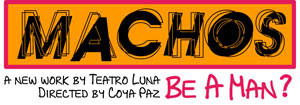
| | Presented byCHICAGO FOUNDATIONFOR WOMEN'S
Latina Leadership Council|
6:30 p.m. wine and cheese reception
8-9:30 p.m. performance
Friday, Nov. 9
Chicago Dramatists
1105 W. Chicago Ave.
Chicago
Call (312) 577-2801 ext. 229. Tickets are $45.
Proceeds from this event benefit the Unidas Fund
of the Latina Leadership Council.
No refunds or exchanges.
A world premiere production, "MACHOS"
is an interview-based play about
contemporary masculinities.
As always, Teatro Luna asks
hard-hitting questions, such as:
Exactly how did you learn to use the urinal?
"MACHOS" presents a range of true-life stories
with Teatro Luna’s trademark humor and unique
Latina point-of-view. "MACHOS" follows
Teatro Luna's critically-acclaimed shows
"S-E-X-OH" and "LUNATIC(A)S."
It moves beyond the everyday stereotypes
of gender, offering a complex look at how 50 men
(and eight Latina women) learned how to be men.
Performances are drawn from interviews
with 50 men nationwideand performed
by an all-Latina cast in drag.
After the performancethere will
be a reception with director Coya Paz and the actors.
Featuring Belinda Cervantes,
Maritza Cervantes,
Yadira Correa,
Gina Cornejo,
Ilana Faust,
Stephanie Gentry-Fernandez
and Wendy Vargas.
Learn more about the Latina Leadership Council
of Chicago Foundation for Women.
Chicago Dramatists is wheelchair-accessible.
If you have other accesibility needs or questions,
please contact Marisol Ybarra by Nov. 6 at
(312) 577-2836 / TTY (312) 577-2803 or [email protected].
The 17th Annual Gwendolyn Brooks
Conference on Black Literature and Creative Writing
Fine Fury: Celebrating Gwendolyn Brooks at 90
October 17-20 2007 Chicago State University
As for that other kind of kindness,
if there is milk it must be mindful.
The milkofhumankindness must be mindful
as wily wines.
Must be fine fury.
Must be mega, must be main.
-- from Young Afrikans (of the furious)
by Gwendolyn Brooks
Featuring:
Sonia Sanchez
Martin Espada
Ed Roberson
Tayari Jones
Donda West
Cheryl Clarke
Julius E. Thompson
Haki R. Madhubuti
Sterling Plumpp
Angela Jackson
Sandra Jackson-Opoku
Margo Crawford
Camille Dungy
Jacqueline Jones LaMon
Evie Shockley
Adrian Matejka
Gregory Pardlo
Randall Horton
Kelly Norman Ellis
Nnedi Okorafor-Mbachu
Bayo Ojikutu
Kalisha Buchanon
Workshops by Martin Espada and others.
For registration information visit
www.csu.edu/gwendolynbrooks or call 773-995-3750.
Lisa Alvarado |
|
|
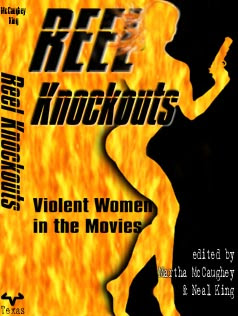
Reel Knockouts celebrates and examines what the authors call "mean women." It is the first book-length treatment of violent women in the movies. Martha McCauley is a Professor of Interdisciplinary Studies at Virginia Technical and Neel King is an Assistant Professor of Sociology at Belmont College in Nashville. Both have written and lectured extensively on the themes of gender, violence and popular culture.
This book doesn't pander to a traditional feminist critique which is essentially anti-violence, which rejects any portrayal of women as perpetrators of violence as merely parroting the oppression of the patriarchy. McCaughey and King take the position that the traditional feminist movement offers an equally restrictive construct for women. A universe for women that is hemmed in by giving birth, forming community, and non-violence, and nurturing alone is just as limiting as exclusive warrior culture restricting the lives of men.
The authors argue that is not the business of analysts, artists and theorists to decide which images suit sexist reaction and which feminist revolution, which express dominance and which resistance. Rebellion never exists without oppression, and McCaughey and King reject the standard argument that any images of women in the movies bear the marks of their sexist, heterocentrist, white supremacist origins.
This volume studies violent women in the movies not merely as patriarchal pawns or broken promises but also as possible tools in the liberation of women from racial, class, gender and other political constraints that oppress women and deny them equal chances and equal rights.
The chapters deconstruct a variety of the most well-known of these new women. Starting with Susan Sarandon and Geena Davis in Thelma and Louise, Sharon Stone in Basic Instinct, and Sigourney Weaver as Ripley in the Alien series, the impact of these strong, vengeful, sometimes "amoral" women are placed in a post-feminist context.
They are not bound by conventional ideas of womanhood, love, romance or family. They are quintessential outsiders, sometimes outlaws, having more in common with the wave of male antiheroes made popular in the spaghetti Westerns of the late sixties and indie films of the seventies. But they live on their own terms, sometimes liberating themselves and others, but always resisting external control.
The whole issue of how to portray violence enacted by women is a thorny and complex one. What I appreciated in this book was the author's willingness to allow all schools to contend. What emerges in this collection allows feminists and the public-at-large to questions assumptions about gender, violence, pleasure, dominance, fantasy.
I agree with the assertion in Reel Knockouts that images of powerful women, capable of violence, capable of revenge are important ones to consider. I'm not afraid that these portrayals show women as too deranged, too sexy, or that women will imitate the violence. I feel challenged by looking at and accessing the powerful, and sometimes the dark, if it leads to a fuller expression of the real self. I'm also interested in examining my own ambivalent feelings about violence, and as a writer, mold, deconstruct and exploit them. What I hope comes forth are pieces with layers of meaning, that cut through complacency, and bring that work to an audience.
ISBN:0292752512
ISBN-13: 978-0292752511

By: Lisa Alvarado,
on 9/20/2007
Blog:
La Bloga
(
Login to Add to MyJacketFlap)
JacketFlap tags:
poetry,
theater,
social commentary,
women of color,
women's studies,
social change,
women and performance,
Teatro Luna,
peformance,
Add a tag
OYE-LISTEN! A Bi-monthly Performance Series
About the performance and presenting artists -
Sharmili Majmudar & Amisha Patel, Dawn Herrera/Terry
Teatro Luna and Jane Addams Hull-House Museum join forces to showcase new works by emerging, Chicago-based performing artists. This collaboration aims to provide women artists of color a space to share personal stories and reflect on contemporary social issues facing their community. By remaining true to the lives and experiences of women of color, this series creates bridges among Chicago ethnic communities.
OYE-LISTEN! MONDAY, September 24, 7-9pm
Our Living by Sharmili Majmudar & Amisha Patel
Our Living a collaborative spoken word piece with musical background written and performed by two Gujarati Indian American women that interweaves our experiences and explores identity, sexism, racism, colonization, and re-emergence through reclaiming our true selves. In this piece, we remind ourselves of how our living depends on each other, despite and in the face of the oppression we experience. Through poetry, we reclaim truth and each other.
PORTALES: Mitologia Subjetiva (Matrilineal) by Dawn Herrera/Terry
Something between monologue and performance, PORTALES is a gently surreal portrait of a personal history, offering one possible account of the how borders may be internalized and inhabited. A work in progress, PORTALES will eventually weave together more strands of family narrative to further explore physical, cultural, emotional and spiritual legacies.
For more information about the artists, please visit: www.hullhousemuseum.org.
7pm - 8:40pm Performance
8:45pm - 9:00pm Post-show discussion
Jane Addams Hull-House Museum
Residents' Dining Hall
800 S. Halsted St, Chicago, IL
This is the third event in the series; the first two were standing room only:
make your reservation soon!
This event is FREE. Light refreshments will be served.
Reservations are recommended,
call 312.413.5353
This event is ADA accessible. If you have a disability and need additional accommodations to attend this event, please inform us at the time of reservation
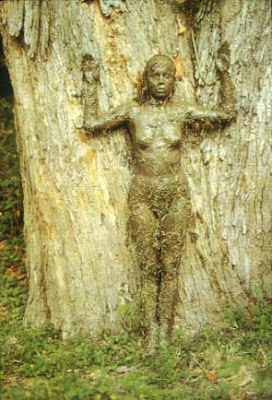
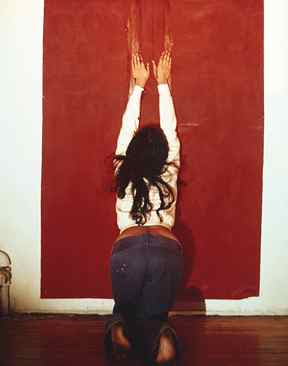
Ana Mendieta was a Cuban performance artist who lived in New York in the 1970’s. The title Where Is Ana Mendieta, not only refers to the suspicious circumstances of her death, but to the nonexistent presence of the work of women artists in mainstream exhibitions, to the absence of work that portrays the aesthetic rooted in Latino cultural identity.
Mendieta boldly explored women’s identity, sexuality, and spirituality in pieces that were deceptively simple. Her work was constructed from the elements themselves, dirt, water, and light in their most basic forms; her themes revolved around the ideas of burial, rebirth, submersion in the natural world. From a perspective beyond the dominant culture's construct of nation, a construct of governments, the hegemony of conquerors, Mendieta's work reverberates with a older, indigenous idea of nation. It challenges the viewer to envision an idea of nation and identity based on a direct relation to the Earth itself.
In a series entitled Tree of Life, Mendieta flattened herself against a large oak tree. She is naked, covered with gesso and paint to simulate tree bark. Where does the tree stop and Medieta begin? Where do we stop and our connection with nature begin? Simply done and deeply resonant. I immediately saw a connection between this piece and a Mexican/Chicano idea of rootedness to place that is not hemmed by borders, but by history and ancestral links to land, to nature itself.
In another, untitled series, Mendieta is shown in a series of photos. Again, she is naked, this time in an isolated field. Next to her is a skeleton. The photos show her climbing onto the skeleton, embracing it. She creates a powerful image of the life/death cycle, as well as a quintessential Latino commentary on mortality. At the heart of existence, life and death are united in an eternal embrace. In the midst of life, its fullness, its lushness, its sensuality, Death is constant companion. While modern, European-based culture constantly seeks to avoid aging and mortality, there are traditions that accept its centrality. Mendieta brilliantly illustrates that death is both the beginning and endpoint of all things.
Mendieta worked closely with a variety of feminist artists, but did not label herself as feminist, and I understand the reticence in using the label. The women's artistic community did not offer a truly supportive relationship, and while she had meaningful connections with individual artists, her work was not be adequately appreciated by feminist and post-feminist critics. In a nutshell, Mendieta did not invent a new relationship to body and Earth, she reclaimed an ancient one, but was never embraced by the 'larger' artistic community.
I was profoundly moved by her work. The work is poetry, visual poetry, poetry made flesh. These are clear, visceral, and direct images that I hope to use as a touchstone in my writing and performing, particularly in performing. I want to tell a personal and universal story with my body, and Mendieta has created a standard for me, as well as strengthening and deepening a physical lexicon.
Blocker’s writing is dry and extremely formal, making this difficult going as a reader, but don't be dissuaded by that. I wonder if some of the density of language was more an expression of Blocker's own inability to grasp and express the power and simplicity of Mendieta. However, the book sings when Blocker allows the work to speak for itself.
ISBN-10: 0822323249
ISBN-13: 978-0822323242
xxxxxxxxxxxxxxxxxxxxxxxxxxxxxxxxxxxxJane Blocker is a specialist in contemporary art and critical theory. She offers courses such as Art Since 1945, Contemporary Art, Alternative Media: Video, Performance, and Digital Art, as well as courses on gender and sexuality, and 20th century theory and criticism.
Her research has focused primarily on performance art as it developed concurrently with postmodern, feminist, and constructionist theories. Her first book, Where is Ana Mendieta? Identity, Performativity and Exile (Duke University Press, 1999), considers the artist's work in relation to the performative production of identity. What the Body Cost: Desire, History, and Performance. (Minneapolis: University of Minnesota Press, 2004), her second book, critically examines the historiography of mid-twentieth century performance. Her current book, called Seeing Witness: Essays on Contemporary Art and Testimony, examines the witness as a privileged subject position by analyzing installations, performances, photographs, and films by such artists as Alfredo Jaar, James Luna, Eduardo Kac, Christine Borland, Felix Gonzales-Torres, and Ann Hamilton.
In addition, she has published the following essays: "This Being You Must Create: Transgenic Art and Seeing the Invisible," Cultural Studies 17, no. 2 (2003): 192-209; "A Cemetery of Images: Meditations on the Burial of Photographs," Visual Resources XX, no. 2 (May 2004) ; "Binding to Another s Wound: Of Weddings and Witness," in After Criticism: New Responses to Contemporary Art, edited by Gavin Butt. (London: Blackwell, 2005); "Failures of Self-Seeing: James Luna Remembers Dino," Performing Arts Journal XXIII, #1 (January 2001):18-32; "The Art of Renters," in From Your House to Our House, exhibition catalogue (Atlanta: Nexus Contemporary Art Center, 1999); "Woman-House: Architecture, Gender and Hybridity in What's Eating Gilbert Grape?," in Camera Obscura 39 (November 1998):126-150; "Ana Mendieta and the Politics of the Venus Negra," in Farquhar, et al, eds. (Un)fixing Representation, special issue of Cultural Studies 12, #1 (January 1998):31-50; "The Bed Took Up Most of the Room," in Peggy Phelan and Jill Lane, eds., The End(s) of Performance (New York: N.Y.U. Press, 1997); and Nancy Spero/Leon Golub: Contemporaries, exhibition catalogue (Detroit, MI: Wayne State University, Elaine L. Jacob Gallery, 1997).
Lisa Alvarado

By: Lisa Alvarado,
on 8/22/2007
Blog:
La Bloga
(
Login to Add to MyJacketFlap)
JacketFlap tags:
dance,
non-fiction,
feminism,
danza,
social commentary,
women's studies,
social change,
political art,
Latina performance,
Antonio's Gun,
Sam Quinones,
Add a tag
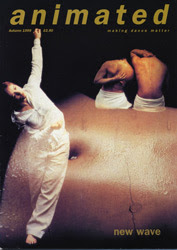
Christy Adair is a freelance writer and cultural critic, contributing to such dance journals as Spare Rib and Everywoman. Women and Dance: sylphs and sirens (Macmillan, 1992), is a text used on dance and performance courses in Britain, America and Asia. Adair contributes reviews and articles to journals, magazines, radio and television both nationally and internationally. She also facilitates a range of performance and education events. Adair is a Reader in Dance Studies at York St John University and is committed to radical performance which communicates an exhilaration of moving and challenges social contexts. Christy has significant links with the dance performance industry both locally in the UK and internationally. Her current research interests focus on gender and ethnicity in relation to dance studies and performance. Her forthcoming book is entitled Dancing the Black Question: The Phoenix Dance Company Phenomenon.
In Women and Dance, Adair introduces the reader to an analysis of Western dance from the point of view of gender and post-feminist analysis. Despite the traditionally high profile of women as principal dancers, Adair asserts that modern Western dance is far from a woman-centered medium. Due to the lack of women choreographers and directors, the genre’s vision of women continues to be rooted in patriarchal notions of the female. It is a representation of the female body that is seriously limited, still unable to reflect the depth of women’s reality.
Adair sees the most synchronous images of women having their origins in dance/performance companies that evolved as in the period post 1970. According to Adair, these groups reflected the fluid, politically progressive images of women following the last wave of the feminist movement. Their major contribution was the development of a type of performance that pushed the boundaries of gender and sex-role expectations. In a piece entitled She Is Giving Birth to Herself, Adair describes how the group Bush Mama explores the primacy of woman relating to other women, not woman-as-male-love-object.
The most useful portion of the book was: “The subversives...women’s dance practices.” It underscores Adair's central tenet that images of women will only be expanded with women themselves taking control of developing, directing, and mounting their own work. This, according to Adair, must occur despite the social and economic barriers involved.
This is particularly potent for me as I try to work more on dance and spoken word pieces. I came to the same realization over the last ten years that I needed to do whatever was necessary to control my own work, how it was showcased, etc. It's also an opinion I've shared with other writer/performers, such as Tara Betts and Sharmili Majmudar, as well as initial discussions with dramaturg and performer Coya Paz, founding member of Teatro Luna here in Chicago.
My only two hesitations in recommending Women and Dance are these: it's an extremely dense read, which made for laborious, although worthwhile reading, and that the book is expensive and better gotten through library sources. But simply put, Women and Dance a vital sourcebook for women performers across the board.
- ISBN-10: 0814706215
- ISBN-13: 978-0814706213
xxxxxxxxxxxxxxxxxxxxxxxxxxxxxxxxxxxxxxxxSpeaking up about immigration ---
Sam Quinones's new book ANTONIO'S GUN AND DELFINO'S DREAM,
a book of vignettes on immigration that has been lauded in the San Francisco
Chronicle, Los Angeles Times, Publishers Weekly, and Library Journal,
as well as having been featured by La Bloga's Daniel Olivas.
Quinones has spoken about immigration--indeed a hot topic again as
Homeland Security begins cracking down on companies that hire
"illegals"--on NewsHour, NPR, and CSPAN.
The newest feature of Sam's website, www.samquinones.com is a link
where the public can tell their "True Tale," the name of which taken
from Sam's first book, TRUE TALES FROM ANOTHER MEXICO.
Here's the link, which has five or six stories from people on it.
http://www.samquinones.com/other_stories.asp
Lisa Alvarado

By: Lisa Alvarado,
on 8/19/2007
Blog:
La Bloga
(
Login to Add to MyJacketFlap)
JacketFlap tags:
Meurent,
Manet,
Impressionism,
biography,
non-fiction,
authenticity,
women's studies,
visual art,
Raúl Niño,
raulsalinas,
raulsalinas,
Add a tag
Mind you, gente, there can be no substitute for a Daniel Olivas post, but he's getting a little well-dererved R & R, so consider this a humble placeholder. -- LA
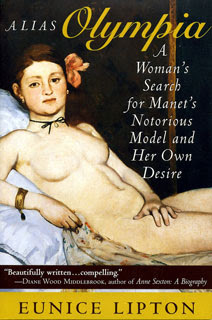
Alias Olympia
by Eunice Lipton
In
French Seduction, art historian Eunice Lipton explores her sensual obsession with the icon of France, the pool of memory and the way that obsession is fused to a contradictory history of her childhood and her connection to the Holocaust. But before that, Lipton authored a biography on Degas and in
Alias Olympia, she attempts to cast light on a pivotal, but now obscure figure in the Impressionist movement.
Victorine Meurent was the model for Manet’s notorious painting, Olympia. In it, Manet re-stages that ancient pose of the odalisque, however,
Victorine appears in the painting as bold, sexually aware and powerful. This caused an outrage in Paris at the time, and sadly, is still the reaction a sexually self-aware woman receives in present time. I stumbled upon this book, looking for more role-models, fodder, inspiration, other lifelines.
I was glad this book found me. The story is so much more than the telling of the painting controversy.
Meurent was an artist, a brilliant one in her own right. She and her work were buried in a barrage of lies as result of her posing for Manet. The popular story about
Meurent was that she had descended into prostitution, drunkenness and despair. Not so different than the double-standard of scrutiny and criticism that women who push the barriers, especially, barriers of the body and sexuality continue to face. There still is a threat, albeit more sub-
rosa perhaps, that in claiming one’s full physical and sexual power, a woman leaves herself open to the psychic version of public stoning for her ‘lewd’ behavior.
While
Meurent did know despair, it was one born out of a career thwarted, and a reputation slandered. She lived a ‘comfortable’ life as bourgeois wife, but not one in which she could move freely, express her ideas or create within the confines of women’s roles at the time. Lipton wrote the book in a narrative style, so that it reads and moves like a novel. No stuff of fiction here, but the complex and brilliant story of a women who dared conventions, and was meted out the punishment of a gilded, dulled existence and obscurity as a result.
I was struck with how women are still offered the choice of ‘comfort’ vs. authenticity, with the implied message that an authentic will surely be the more painful one, the one with the greatest social and emotional costs. To the extent that this blackmail is still being played out, Lipton’s book is a sadly cautionary tale.
ISBN-10: 0801486092 ISBN-13: 978-0801486098
xxxxxxxxxxxxxxxxxxxxxxxxxxxxxxxxxxxxxxxxxxx
Mas y Mas
Raúl Niño , author of
Book of Mornings will be appearing at:
Rudy Lozano Branch Library, 22 August at 7:00PM
1805 South Loomis Street
Chicago, Il 60608
312-746-4329
Please come and enjoy the readings, and diversity of Chicago neighborhoods.
And also.....
In preparation for City of Austin's Mexican American
Cultural Center's grand opening September 15, 2007,
The Public is invited to a MEET AND GREET Sneak
Preview featuring--
AMORINDIO:
Tributo y Celebracion forraulrsalinas/Fundraiser for Red Salmon Arts: Join usto honor and celebrate the life of Austin's elder
Xicanindio poet/human rights activist. A veterano of
Chicano literature/letters, raulrsalinas' writing and
activism have earned him international recognition as
a spokesperson for a diversity of political causes,
ranging from prisoner rights and national liberation
struggles to gang intervention and youth arts
advocacy.
raulrsalinas is the author of three collections of
poetry: Un Trip Thru the Mind Jail y Otras Excursions
(Editorial Pocho-Che, 1980; Arte Publico Press, 1999),
East of the Freeway: Reflections de mi pueblo (Red
Salmon Press, 1995), and Indio Trails: A Xicano
Odyssey thru Indian Country (Wings Press, 2006).
Recently, UT Press published a selected collection of
his prison wirtings, raulrsalinas and the Jail
Machine: My Weapon Is My Pen (edited by Louis Mendoza,
2006).
The tribute will feature performances and
presentations by renowned Chicana/o and Latina/o
writers and scholars:
Miguel Algarin (NYC),
SandraCisneros (San Antonio),
Carmen Tafolla (San Antonio),
Norma E. Cantu (San Antonio),
Alejandro Murguia (San
Francisco),
Rosemary Catacalos (San Antonio),
sharonbridgforth (Austin),
Roberto Vargas (San Antonio),
Tammy Gomez (Fort Worth),
Celeste Guzman Mendoza(Austin),
Levi Romero (Albuquerque, NM),
Tony Spiller(NYC),
Jessica Torres (San Antonio).
Presenters on raulrsalinas' life include:
AntoniaCastaneda (San Antonio),
Roberto Maestas (Seattle,
WA), and Alan Eladio Gomez (Ithaca, NY). There will
be an opening ceremony by
Danzantes Concheros y musica
movimiento Chicano by
Conjunto Aztlan.
The celebracion will also include a Silent Art
Auction, curated by Chicana artist Jane Madrigal, with
over 30 pieces by artists throughout the Southwest,
and food and refreshments provided by Alma de Mujer
Catering Dept.
All proceeds will support
Red Salmon Arts, a Native
American/Chicana/o based cultural arts organization
with a history of working within the indigenous
communities of Austin since 1983. This event is
sponsored by
Red Salmon Arts, Alma de Mujer, PODER,
and UT Press. $10 dollar suggested donation.
Saturday, August 25, 2pm - 7pm.Mexican American CulturalCenter, 600 River Street.For more info:512-416-8885/ [email protected].Donation: Please send to Red Salmon Arts, 1801-A South
First St., Austin, TX 78704 Austin, TX.
For tax-deductible contributions, please contact Rene
Valdez first at
[email protected]Bios for Performers:
Miguel Algarin (NYC) is the "poet laureate" of the
Lower East Side - and founder of the Nuyorican Poets
Cafe in New York City, where he has nurtured the
spoken and written word for nearly three decades.
Sandra Cisneros (San Antonio) is an American novelist,
short-story writer, essayist, and poet, whose works
helped bring the perspective of Chicana women into the
literary mainstream. Author of House on Mango Street,
Loose Woman, and Caramelo, among other works.
President and Founder of the Macondo Foundation.
Carmen Tafolla (San Antonio) is an internationally
acclaimed writer and regarded as one of the masters of
poetic code-switching. She often employs the
bilingual idiom of her native San Antonio’s Westside
in her poems. Author of various works, including
Sonnets to Human Beings, Sonnets and Salsa, and
Curandera.
Rosemary Catacalos (San Antonio) is the author of
Again for the First Time (Tooth of Time Books, Santa
Fe, 1984). A past Dobie Paisano Fellow, Stegner
Creative Writing Fellow, and the recipient of an NEA
grant, she has been the Executive Director of Gemini
Ink since 2003.
Norma E. Cantu (San Antonio) currently serves as
professor of English at the University of Texas at San
Antonio. She is the author of the award-winning
Canicula Snapshots of a Girlhood en la Frontera, and
co-editor of Chicana Traditions: Continuity and
Change.
Alejandro Murguia (San Francisco) is is a two-time
winner of the American Book Award, most recently for
This War Called Love: Nine Stories, City Lights Books.
His memoir The Medicine of Memory: A Mexica Clan in
California, University of Texas Press, has been
nominated for the Victor Turner Prize in Ethnographic
Writing.
sharon bridgforth (Austin) is the Lambda Award winning
author of the bull-jean stories (RedBone Press), and
love conjure/blues a performance/novel (RedBone
Press). Bridgforth has broken ground in the creation
and presentation of the performance/novel and in doing
so has advanced the articulation of the Jazz aesthetic
as it lives in theatre.
Roberto Vargas (San Antonio) is a community/labor
organizer and author of two poetry collections:
Primeros Cantos and Nicaragua, yo te canto besos,
balas y sueños libertad. He was a founding member of
The Pocho Che Collective, a loose coalition of writers
who published some of the first books of the
contemporary Latino literary renaissance taking place
in San Franisco.
Tammy Gomez (Fort Worth) is a native Texas writer and
performance poet, is featured in the PBS documentary
"Voices from Texas." She has published the work of
Yoniverse, a women's poetry group she founded, in the
anthology In a Loud Kitchen (Tejana Tongue Press,
1998); a second anthology, North Texas Neruda Love,
published by Tejana Tongue Press, was released in
January 2006.
Levi Romero (Albuquerque, NM) is an Embudo Valley poet
& author of In the Gathering of Silence (West End
Press).
Celeste Guzman Mendoza (Austin) is a San Antonio
native. Her poetry has appeared in journals such as
Salamander, Poet Lore, and 5 a.m., and in various
anthologies, including Telling Tongues, Red Boots and
Attitude, and Floricanto Si. She won the Poesia Tejana
Prize in 1999 from Wings Press for her chapbook of
poems, Cande te estoy llamando.
Jessica Torres (San Antonio) is a youth filmmaker,
activist, visual artist, and singer/musician. Her
short film, Los Punkeros, Chicano punk rock movement
with a twist of Conjunto, appeared on San Anto TV, a
TV Magazine produced by local youth through the San
Anto Cultural Arts Multi Media Institute (SAMMI).
Bios for presenters:
Antonia Castaneda (San Antonio) is a Chicana feminist
historian, teaches in the Department of History at St.
Mary's University. Her research and teaching interests
focus on gender, sexuality, and women of color in
California and the Borderlands from the 16th century
to the present.
Roberto Maestas (Seattle, WA) is the co-founder and
Executive Director of El Centro de la Raza, a center
for Seattle’s Latino Community. He has long been
involved in the ongoing struggle for civil rights in
the city.
Alan Eladio Gomez (Ithaca, NY) earned a Ph.D. in
History and an M.A. in Latin American Studies from the
University of Texas at Austin. A community organizer,
scholar, and radio journalist, Gómez studies post WWII
social movements involving multiracial and
transnational alliances of U.S. Third World peoples,
prison rebellions, political theater, and Latin
American revolutionary movements.
Bio for Conjunto Aztlan:
Conjunto Aztlan (Austin) represents a spiritual and
musical journey expressed through poetry and song.
The Conjunto was born of the Xicano Movement in
Austin, Texas, in 1977. Their purpose is to
celebrate, defend, and expand the musical, cultural,
and spiritual legacy of the Chicano people.
Lisa Alvarado
View Next 4 Posts
A peasant’s utopia, as imagined in Giovanni Boccaccio’s Decameron, includes a mountain of grated Parmesan cheese. Peasants do nothing else except make macaroni and ravioli all day long in the imagined fairyland. In the book of Exodus, the Promised Land is one of “milk and honey.” And according to Hinduism, during the creation of the world, the Cow of Plenty emerged during the Churning of the Ocean – literally the changing of the white ocean into butter. Deborah Valenze explains in Milk: A Local and Global History, how the “elixir of immortality” changed from a staple of the gods to a staple of nutrition textbooks.













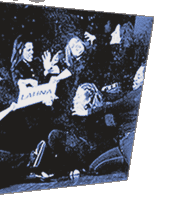






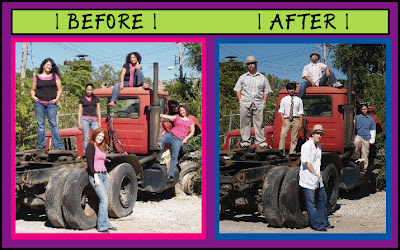


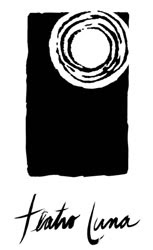





Thanks for writing on this work, Michael. I loved this book as it deals with so many important issues, ends with the female protagonist's emotional growth, despite the circumstances, and it is beautifully written.
However I will say it is very dark. You called it an almost unbearable tension, but for me at times, particularly when she was in prison, I felt that the author gave us no hope for Concepcion, and that made it hard to read. But all in all an incredible and intricately beautiful novel.